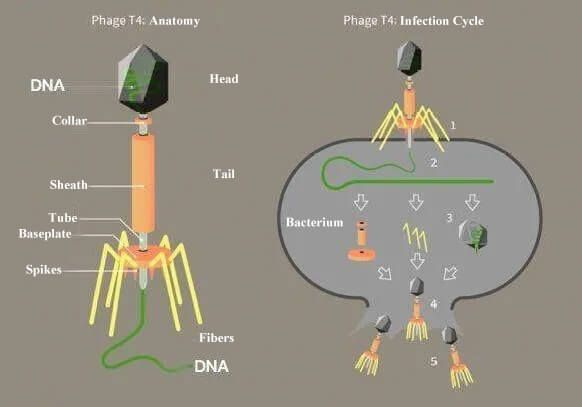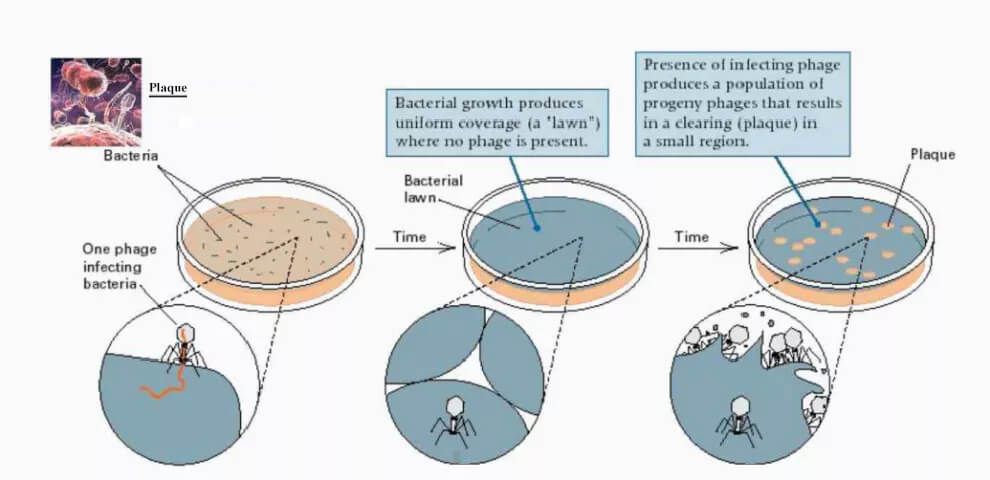Abstract: Phage is a kind of virus attacking bacteria and also known as bacterial virus or bacteriaophage. Phage comes from Greek word "phagos" and means "phagocytosis".
Keywords: Phage, Infection Cycle, Parasitism
1. Phage Features
Phage has all features of common virus:
- Non-cellular life, its structure mainly consists of protein and nucleic acid(DNA or RNA);
- They can just live by obligate parasitism in living cell and rely on the metabolism of their hosts. By copying nucleic acid with the assistance of their hosts, components like proteins are synthesized, assembled and proliferated. Under in vitro condition, they can exist in the state of nonliving chemical macromolecules and keep the infective activity;
- Very specialized parasitism. In the natural environment, they can only infect bacteria and some protists except higher organisms and plants;
- Insensitive to general antibiotic, but sensitive to interferon(IFN);
- The small phage can pass through sterilization filter
There is no individual growth process in phage. Only synthesis and assembly of basic components exist. Thus, the reproduction of phage is usually called copying.
2. Virulent Phage
Virulent phages are copied and proliferated in host bacterium. Many filial generation phages are produced. After increasing to a certain number, solubility of phage synthetase will lead to the host cell lysis. Released phages will infect other sensitive bacteria again.
3. Temperate Phage
Temperate phages are not proliferated after infecting host bacteria and will integrate the gene on bacterial chromosome to form the prophage. In the stage of prophage, the copying of phage is inhibited. The host cell regularly grow and reproduce. The phage genome and host bacterial chromosome are synchronously copied and will be passed to progeny cells with the cell division.

4. The Harm of Phage
Bacteriophagy: Dissolved oxygen in liquid medium rapidly rises and large numbers of bubbles are formed. In a shorter period, a lot of bacteriums are autolyzed. Fermentation broth gets clear finally. Plaque appears in solid medium.

The fermentation using bacteria or actinomycetes is easily infected by phages. Phages have strong infectivity and are rapidly spread. They are hard to be prevented and greatly threaten fermentation production. Once infected by phages, the fermentation is abnormal and reladled. Industrial production suffers heavy losses.
5. Prevention Methods of Phages
- Foreign suspectable bacteria are not proliferated
- Various bacteria are used in turn. Adopt the competence against phages
- Divide the operation area of E.coli strictly: inoculation area, fermentation area, collection area, culture preservation area
- Strictly forbid emission of living bacteria. Waste bacteria can be poured out after sterilization;
- Avoid pollution by standard operation;
- Ensure the clean and dry working environment
6. Inactivation Methods of Phages
High Temperature
Most viruses are resistant to cold but not heat and can be inactivated by high pressure steam or dry heat 180°C.
pH
Most viruses are stable between pH6-9. They can be rapidly inactivated under pH5.0 or above PH9.0.
Ray
Viruses can be inactivated by gamma ray, X-ray and ultraviolet.
Phenol, aldehyde and its Derivatives
Protein denaturant can destroy capsid protein of the virus.
Oxidant, Halogen and its Derivatives
Most viruses can be inactivated by 70% methanol or ethanol
Formaldehyde is harmful to human body. Although the fumigation effect is obvious, many labs don't have this condition.
7. Suitable Experimental Methods
Surface Disinfection
84 or benzyldodecyldimethylammonium bromide can be applied in surface disinfection.
UV Irradiation
254nm UV is used to irradiate overnight.
Ozone Sterilization
Ozone is used to sterilize bacteria overnight. In the morning, ventilate the room for 1 hour. There is no residue. As green disinfectant, ozone has strong inactivation effect on E. coli, hepatitis B virus, staphylococcus aureus and pseudomonas aeruginosa etc. The sterilization speed is 3000 times than ultraviolet. The half-life of ozone is between 20-50min. The final decomposition is oxygen. Hence, there is no residual pollution for people and things.
![]()
